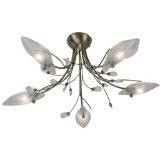We recently purchased a new light fitting from Next.
If we were to install the product as pictured, then due to the length of the chain, we would be bashing our head into the light fitting every time we walked under/close enough to it.
We therefore need to remove the chain (i.e. make as short as possible), which we can do, but we also need to have the top of the spokes (see picture) flush with the ceiling height.
This would mean that the ceiling cup (labelled in the picture) would need to be in the void between the ceiling and the floor of the room upstairs.
However, as can be seen from the picture, the ceiling cup has a set of vents around it, presumably to allow the heat from the transformer to dissipate.
Is it permissible (and safe) to install the ceiling cup in the void between the ceiling and the floor of the room above, and if so, how are issues of e.g. condensation in the void dealt with?
i.e. would we need to build a plasterboard box around the ceiling cup that was:-
(a) big enough to allow the heat from the ceiling cup to dissipate enough that it wouldn't overheat the transformer; and
(b) tight enough to prevent moisture from getting into the transformer?


If we were to install the product as pictured, then due to the length of the chain, we would be bashing our head into the light fitting every time we walked under/close enough to it.
We therefore need to remove the chain (i.e. make as short as possible), which we can do, but we also need to have the top of the spokes (see picture) flush with the ceiling height.
This would mean that the ceiling cup (labelled in the picture) would need to be in the void between the ceiling and the floor of the room upstairs.
However, as can be seen from the picture, the ceiling cup has a set of vents around it, presumably to allow the heat from the transformer to dissipate.
Is it permissible (and safe) to install the ceiling cup in the void between the ceiling and the floor of the room above, and if so, how are issues of e.g. condensation in the void dealt with?
i.e. would we need to build a plasterboard box around the ceiling cup that was:-
(a) big enough to allow the heat from the ceiling cup to dissipate enough that it wouldn't overheat the transformer; and
(b) tight enough to prevent moisture from getting into the transformer?




